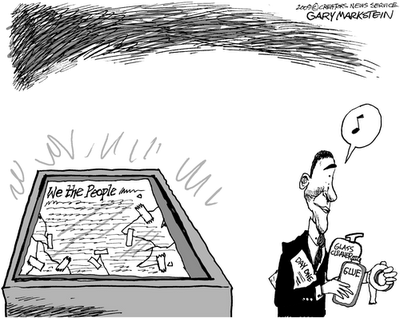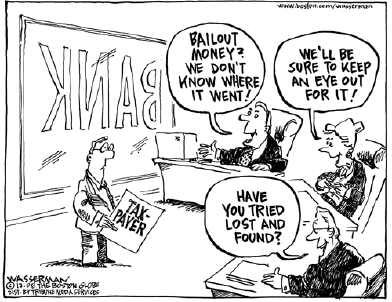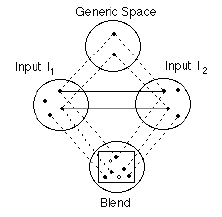The end of capitalism or the end of the state?
FULL TEXT:
http://www.thinkartlab.com/pkl/media/Bailout Strategies/Bailout Strategies.html
http://www.thinkartlab.com/pkl/media/Bailout Strategies/Bailout Strategies.pdf
2. Bailout logic
"In economics, a bailout is an act of loaning or giving capital to a failing business in order to save it from bankruptcy, insolvency, or total liquidation and ruin.”2
Detailed material and description about the complex aspects of the USA bailout is summarized at Emergency_Economic_Stabilization_Act_of_2008.3 Or watch the video:Why Wont The Bail Out Work? 4
There are funny discussions about the nature, probably it is better to call it, the ideology and stratagemes, of what’s going on today in the economic world.
The funniest chapter is the emergence of an ever growing debate about the transformation of the relationship between capital, economy, market and state, governments, administrations, bureaucracy.
Things are not as funny as they could be. The biggest economic crises since the last big crash is producing serious global poverty and will become a good reason for further wars.
What’s annoying me is that the same stupidity of our ruler and their academic adviser is going on without any interruption or critical reflection on what happened and is still happening.
The same politicians and Nobel Prize Winners are on the floor.
Do we have to enter this debate?
There is no need to get messed up about their opinions.
It seems to be good enough to think about the most simple structure of the whole manoeuvre to understand its logic and strategy.
The state, of whatever governmental form, from the Swiss democracy to Gordon Brown’s British parliament, the USA to China, the state is asked for or is offering a bail-out of companies, corporations, institutions which are running into bankruptcy.
The bail-out is paid by so called tax payers money. Hence, the state will take over such companies to some degree in ownership and regulations. It is seen as a reversal of the process of privatization. Some, are happy to interpret it as the symptoms of the end of capitalism.
There are others, not many, for good reasons, which are more cynical and are understanding the bail-out manoeuvre of the state as a coup of the capital to overtake the state with its tax payer's money and its power of regulation.
This position in the debate is still hidden in the background. It would be too dangerous to defend such a complementary position explicitly and with the proper intensity.
It is said that the state will take shares of the companies and will use more control over them. Does it matter? There will be bankers and managers from the side of the capital which will enter the save heaven of governmental offices to do the job. Hence, the capitalist bankers are becoming administrators and the governmental administrators are becoming bankers.
The governmental bankers, which had been in charge to control the capitalist banks, are as much involved in the crash as their colleagues from the so called private sector.
Both positions of the debate, surely, are demanding for themselves unique truth of their interpretations. Only debaters with some secured positions are liberal or tolerant enough to accept, at least, the existence and relative reasonability of the complementary position. But that doesn’t matter, now.
Hence, we are at the beginning, again. The crisis is declared as much too serious to allow the luxury of philosophical reflections and distinctions and is only weakening, argumentatively, the severity of the global situation.
In fact, there is, up to now, no debate at all. The opposite position to ones position in this virtual debate is declared as mislead and for empirical and logical reasons as wrong.
It is still the dominating position that the government has to save the failing industries (banks, car, insurance, etc.) with the help of bailout strategies.
The government declare, it will use the tax payers money properly, fulfilling highest standards of economical thinking and ethics.
It doesn’t matter, where the money is from, directly from the national tax payer or indirectly, via China e.g. The government wasn’t elected to spend this money especially for bailouts, anyway.
Is the tax payers money private or public?
Is a tax payer private? What happens if the so called worker is his own capitalist? A shareholder of “his” company for which he is now on the way to pay his bailout with the generous help of the government? And the capitalist, e.g. the manager his own (self-)exploiter?
Hence, the tax payer is paying the bailout of his company where he is a shareholder and a worker at once, which makes him a owner of the company, which is, together with him, on the way to bankruptcy. This surely has to be prevented, otherwise the tax payer gets unemployed and is losing his status as a shareholder of his company.
It also has to be prevented because the tax payer could start a rebellion against the whole system, paid on the base of his private money he put aside. But how and where?
There are no capitalists nor workers, anymore. Both are intertwined into the complex reality of globalization and the self-exploitation by anonymous corporations.
That is, public money from the private tax payer has to save the private company owned by the capital. The state wants to become a part-owner of the capital with the money of the private shareholders of the company.
The mission is to save employment for the private shareholders.
This sounds humanitarian and is in harmony with a progressive protestant work ethic.
But this is only one side of the coin.
Is it not better for the public capital and the markets to get as much capital by the state’s private capital to be fit to survive against the consequences of mismanagement and global competition?
In fact, and this will become, in the future, more and more obvious , the capital has to be made fit against the cultural limitations of Western science and technology and their decline.
The so called nationalization of markets is in fact a disguised overtaking of the state by the capital.
The state, complementary, is hallucinating a control and annexation of the markets and the capital. He wants to become owner of the banks, etc.
The bailout ‘’Promotes centralized bureaucracy by allowing government powers to choose the terms of the bailout.‘’ (WiKi)
The state is playing the rescuer of the markets to save its own existence.
The capital is overtaking in disguise the state to save its own existence.
Therefore, the whole bailout saga is a secret coup:
coup d'´etat and coup de capitale.
The common of both is the commotion and the threat of their proper existence.
Both forms of existence are fundamentally out of date and obsolete.
The epistemological problem is:
The (bailout) situation is polycontextural and self-referential, and our mathematical and computational paradigms, ideologies and tools are mono-contextural and linear.
[...]
3.2. Blending of bailout
The blending interpretation of the bailout is blinding for the fact that the emergent features of whatever mélange between capital and state has first to be generated and paid.
But a blending approach,with its undecided mix, is best prepared to offer the necessary structural vagueness and non-transparency for ever growing new departments in the opacity of both administrations, the state and the capital.
3.3. Chiasm of bailout
Inter-dependencies of both, capital and state, still intertwined and reciprocatively dependent, but at least a holistic and processual conceptualization and understanding of the mechanism is uncovered and conceived by the chiastic thematization of the bailout..
The chiastic approach of the bailout is emphasizing the complicity of both movements, the privatization and the nationalization, as belonging to the same reality.5
Hence, any controversial debate, like with the logical, contradictorily or antagonistic, modeling, which is understanding the parts as singular or in a reflective turn as dual, is obsolete within the chiastic understanding.
What has to be studied is the inter-relational complicity of both interpretations, their chiastic relationality, like the coincidence and exchange relations. To function as a whole of interdependency, the exchange relations between the opposite, but common terms have to be adapted by the coincidence relations between the similar but distributed terms.
The dualistic interpretation of the situation is conflictive and is not offering a tribune for negotiation. One, and only one interpretation is accepted by the defenders as adequate and true. On the base of such blindness, only ethical and moralizing judgements and the cry for more interventional actions are available.
The chiastic interpretation is offering an insight into the very mechanism of the conflictive situations. The mediating contextures of the chiasm is placing the structural possibility of negotiation and resolution, albeit inside of the framework of the scenario.
Both positions, the dualistic and the chiastic, are accepting the situation as it is. This is reasonable for descriptive and analytical motives. Despite its non-classical conceptuality, the chiastic model is not yet offering any structural strategies to overcome and reject the structural fundaments of the whole situation.
As a result, a kind of a humanitarian harmony of the antagonism remains as the ultimate aim. This solution of the problem is guaranteeing a safe return of the problem on a new, more complex and reflected level of development, securing an even deeper and broader stage-management of the “eternal recurrence” of booms, bubbles and crashes.
3.4. Diamond of bailout
The diamond approach is not denying the correctness of the chiastic modeling of the antagonistic situation but is trying to reject the whole construction in favor of a future-oriented transformation, where the components or “objects” of the chiasm, state and capital, are dissolved.
The diamond approach, with its complementarity of acceptional and rejectional thematizations, is separating the antagonistic aspects from their intertwining complicity. Both are conceived as autonomous societal movements, crossing at some parts, historically, and disappearing into other situational interactions.
Their complicity is historic and there is no necessity to reduce social life to it.
Because of the autonomic interplay between acceptional tendencies, framed by categories and rejectional tendencies, framed by saltatories, a chance to separate both structurations (of societal structures and movements) is conceived and accessible to realize.3.5. The bailout of the bailout
Rejection of the figure of bailouts by dissemination and subversion.
The bailout of banks and industries by the governments is a big sandbox game: moving money, power and control from one societal heap to another societal heap of a national and/or global economy framed by the opposition of capital and state.
3.5.1. Dissemination: Polycontexturality of society
Polycontexturality of society is dissolving such terminological identifications like ‘state’ and ‘capital‘. Terms, like ‘state’ and ‘capital’, are not observer-independent identifications, like ‘potato’ or ‘herring’, which in fact are neither. They are depending on observations and are set into multiple perspectives, which are dissolving their a-historical and nominalistic identity.
Polycontextural logics are prepared to describe, formalize and implement such complexities in an adequate way.
Gunther Teubner is describing the challenges for law and society and its understanding by polycontextural thematizations.
"In Habermas’ “ideal speech situation”, formal procedures are supposed to guarantee the undistorted reciprocal expression of individual interests as well as their universalization into morally just norms. However, polycontexturality, one of the most disturbing experiences of our times, thoroughly discredits these recent variations of a Kantian concept of justice.
"With polycontexturality understood as the emergence of highly fragmented intermediary social structures based on binary distinctions, society can no longer be thought of as directly resulting from individual interactions, and justice can no longer be plausibly based on universalizing the principle of reciprocity between individuals.”
"In these perspectives, irreconcilable incompatibilities result from colliding social practices each of them endowed with their own rationality and normativity and with an enormous potential for mutually-inflicted damage.
The highest degree of abstraction has been reached by Gotthard Günther who radicalizes polycentricity into a more threatening polycontexturality, that is, a plurality of mutually exclusive perspectives which are constituted by binary distinctions. They are not compatible with one another and can be overcome only by rejection values which in their turn lead to nothing but to different binary distinctions.” (Teubner, p. 4/5)6
3.5.2. Subversion: Morphogrammatics of sociality A morphogrammatic subversion of the understanding of society is rejecting their leading concepts and models of monetary and phono-logical interpretations.
Subversion, hence is not rejection “which in their turn lead to nothing but to different binary distinctions.” Binary distinctions discovered by rejections are establishing, again, contextures albeit new ones, and thus there is, in this strategy, no escape and nothing left except of contextures, and contextures of contextures.
There is not much to tell about such a morphogrammatic turn or abstraction, i.e. subversion, and it is hard to write and to inscribe how to subvert the surface structures of society to ‘enlight’ its hidden actional structuration by morphogrammatics.
Morphogrammatics is abstracting even from “the highest abstraction” (Teubner) of the contextures of polycontexturality.
To try it with metaphors, it seems to be reasonable, in what ever logic or rationality, that contextures too, are taking place, are positioned and localized, where?, in a kind of space(s). Such a space might be called an inscriptional space or even more metaphorically a (meta-/proto)conceptual space, giving space and loci for éspacement (spacing) and temporalisiation of positioned contextures and their interplay. Such a space is empty of all kinds of conceptual characterizations but it is nevertheless not a vague void, but structured, organized, beyond the dictatorship of order and chaos, axioms and rules.
That bailouts for state and capital can happen in a specific societal space, which has to be spaced and temporalized by actions and activities before/after capital and state can happen on/off historical stage of history, bailouts to save living space and future(s) have to be discovered and invented beyond state and capital.
Without fundamental change(s) nothing will be changed for the future.



